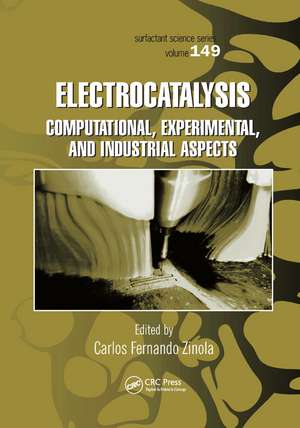Electrocatalysis: Computational, Experimental, and Industrial Aspects
Editat de Carlos Fernando Zinolaen Limba Engleză Paperback – 23 oct 2019
Gathering the experiences of a collection of experts who have worked on the basic principles of electrocatalysis as it applies to theoretical physics and theoretical chemistry, the book gives readers a clear view of the problems inside electrocatalytic reactions, presenting both the limitations of electrocatalysis in the laboratory along with its possibilities in industry.
Topics discussed include:
- The current uses of electrocatalysis
- Future perspectives on the field
- Surface physical properties and surface relaxation on noble and non-noble surfaces
- The quantum nature of the electron transfer
- Müller-Calandra, Srinivasan-Gileadi, and instantaneous nucleation-growth overlap models
- The production, storage, use, and delivery of hydrogen in industrial electrochemistry
- Theoretical approaches to current distribution on rough surfaces
- The use of microradiology to study electrodeposition
- Principles of electrochemical engineering, fuel cell reactors, and electrocatalytic reactor design
- Electrocatalysis of electroless plating
- Fundamental aspects of the corrosion of metals
The book reviews four main electrochemical processes (hydrogen production, oxygen electrochemistry, energy conversion/production, and fine electroplating). Surface modified non-noble metal substrates and natural minerals as well as noble
Preț: 489.26 lei
Preț vechi: 575.60 lei
-15% Nou
Puncte Express: 734
Preț estimativ în valută:
93.63€ • 101.67$ • 78.65£
93.63€ • 101.67$ • 78.65£
Carte tipărită la comandă
Livrare economică 22 aprilie-06 mai
Preluare comenzi: 021 569.72.76
Specificații
ISBN-13: 9780367384364
ISBN-10: 0367384361
Pagini: 666
Dimensiuni: 178 x 254 x 38 mm
Greutate: 0.45 kg
Ediția:1
Editura: CRC Press
Colecția CRC Press
ISBN-10: 0367384361
Pagini: 666
Dimensiuni: 178 x 254 x 38 mm
Greutate: 0.45 kg
Ediția:1
Editura: CRC Press
Colecția CRC Press
Public țintă
Professional Practice & DevelopmentCuprins
About Electrocatalysis Until 2000. Fundamental Aspects of Electrocatalysis. Quantum and Theoretical Electrocatalysis. Overview of Semiempirical Methods. Density Functional Theory. General Considerations of Periodic Crystals. Electrode Catalysis versus Enzyme Catalysis: Theoretical Modeling of a Biological Enzyme. Electrochemically Formed Film Layers of Importance in Electrocatalysis. Surface Physical Properties and the Topology of Single Crystals: Atomic Rearrangements. Problem of Surface Relaxation and Atom Rearrangement on Electrode Surfaces. Surface Chemistry of Bimetallic Catalysts. Surface Modifications of Ferrous Metals and Alloys Induced by Potential and Thermal Perturbations. Principles of Electrochemical Engineering. Energy Balances and Hydrodynamic Conditions in the Electrochemical Reactor. Current Density and Electrode Potential under Different Operating Conditions on Smooth and Rough Surfaces. The Electrochemical Fuel Cell Reactor. Diffusion-Convective Systems in Electrochemical Reactors. Electrocatalytic Reactor Design. Electrocatalysis of Electroless Plating. Fine Electrodeposition. Electrode Modification: Application in Organic Electrocatalysis. Fundamental Aspects of Corrosion of Metals and Semiconductors. Production, Storage, Use, and Delivery of Hydrogen in the Electrochemical Conversion of Energy. Index.
Notă biografică
Carlos Fernando Zinola earned his undergraduate degree in chemistry at the Universidad de la República in 1987, a master’s degree and doctorate in chemistry at the same university in 1991and 1994, and post-doctorate in electrochemistry at Universitaet Bonn in 1996. His main topics of interest are electrocatalysis and industrial applications of electrochemistry and electrochemical engineering. He has written three books, earned three patents, and published more than 60 articles.
Descriere
Recognizing electrocatalysis as an interfacial approach to a dynamic interdisciplinary science, this volume focuses on important developments in the field that are the most relevant to new technologies. The book gives readers a clear view of the problems inside electrocatalytic reactions, presenting both the limitations of electrocatalysis in the laboratory along with its possibilities in industry. Topics discussed include the uses of electrocatalysis and future perspectives; the quantum nature of the electron transfer; Müller-Calandra, Srinivasan-Gileadi and instantaneous nucleation-growth overlap models; and the production, storage, use, and delivery of hydrogen in industrial electrochemistry.
